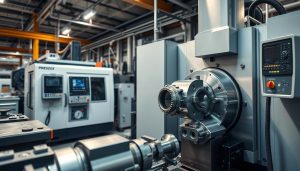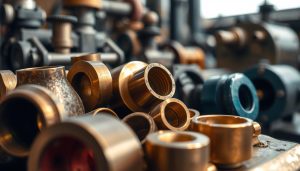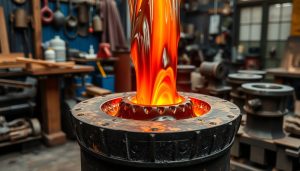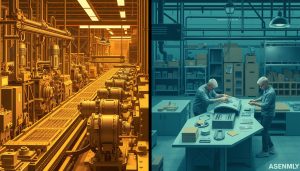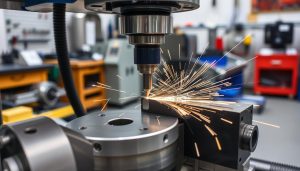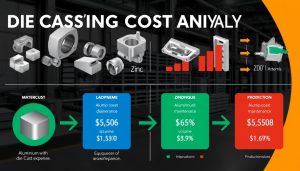In the world of modern manufacturing, the choice of the right CNC cutting method can make all the difference in the success of a project. Whether you’re producing intricate parts, cutting through thick materials, or seeking speed and efficiency, the options of laser, waterjet, and plasma cutting each offer unique advantages. This article will dive into the key differences between these industrial cutting technologies, helping you determine which one is the best fit for your specific needs.
What is Laser Cutting?
In the world of precision manufacturing, laser cutting technology has emerged as a game-changer. This advanced process utilizes a focused, high-energy beam of light to effortlessly cut through a wide range of materials with unparalleled accuracy and efficiency. From industrial applications to custom projects, laser cutting technology has become a versatile tool that continues to transform the way we approach cutting and shaping materials.
Overview of Laser Cutting Process
The laser cutting process works by directing a high-powered laser beam onto the material, typically metal or plastic, to create precise and intricate cuts. The laser beam, guided by a computer-controlled mechanism, precisely follows a pre-determined pattern, allowing for the creation of complex shapes and designs with exceptional detail. This process, known as CNC laser cutting, combines the power of lasers with the precision of computer numerical control (CNC) technology, making it a preferred choice for a wide range of industries.
Advantages of Laser Cutting: Precision and Efficiency
One of the primary advantages of laser cutting technology is its unparalleled precision. The focused laser beam can cut through materials with remarkable accuracy, enabling the creation of intricate and delicate designs that would be challenging to achieve with traditional cutting methods. Additionally, the efficiency of laser cutting is unmatched, as the process is typically faster, cleaner, and produces less waste compared to other cutting techniques. This makes laser cutting an attractive option for a wide range of applications, from architectural fabrication to automotive and aerospace manufacturing.
| Advantage | Description |
|---|---|
| Precision | The laser beam’s pinpoint accuracy allows for the creation of complex, intricate designs with exceptional detail. |
| Efficiency | Laser cutting is a faster, cleaner, and more waste-efficient process compared to traditional cutting methods. |
“Laser cutting technology has revolutionized the way we approach precision manufacturing. Its unparalleled accuracy and efficiency make it an invaluable tool for a wide range of industries.”
What is Waterjet Cutting?
Waterjet cutting is a versatile and innovative technology that has revolutionized the way various industries approach material cutting. Unlike traditional cutting methods, waterjet cutting utilizes a high-pressure stream of water mixed with an abrasive material to precisely and efficiently slice through a wide range of materials, from thick metals to delicate composites.
How Waterjet Cutting Works
The waterjet cutting process begins with a powerful pump that pressurizes the water to incredibly high levels, often exceeding 60,000 psi. This pressurized water is then forced through a small nozzle, creating a focused, high-velocity stream. Depending on the application, an abrasive material such as garnet or silicon carbide is introduced into the water stream, further enhancing its cutting power.
Benefits of Waterjet Cutting: Thickness and Versatility
- Ability to cut through thick materials: Waterjet cutting technology can effortlessly slice through materials up to 12 inches thick, making it an excellent choice for heavy-duty industrial applications.
- Versatility across materials: Waterjet cutting is highly versatile, capable of cutting a wide range of materials, including metals, composites, plastics, glass, and even stone, without the risk of heat-affected zones or thermal distortion.
- Precision and accuracy: The controlled water jet and abrasive mixture allows for intricate, detailed cuts with exceptional precision and accuracy, making waterjet cutting ideal for complex designs and intricate parts.
- No heat-affected zones: Unlike thermal cutting methods, waterjet cutting does not produce heat-affected zones, preserving the structural integrity and finish quality of the cut material.
| Material | Thickness Range |
|---|---|
| Metals (Steel, Aluminum, Titanium) | Up to 12 inches |
| Composites (Fiberglass, Carbon Fiber) | Up to 6 inches |
| Plastics (Acrylic, Polycarbonate) | Up to 4 inches |
| Stone (Granite, Marble) | Up to 8 inches |
The versatility and precision of waterjet cutting technology make it a valuable tool for a wide range of industries, from aerospace and automotive to architecture and art. Its ability to cut through thick, tough materials without compromising quality or structural integrity sets it apart as a highly adaptable and efficient cutting solution.

What is Plasma Cutting?
Plasma cutting is a versatile and efficient technology that has revolutionized the way we cut conductive materials. Unlike traditional cutting methods, plasma cutting utilizes a high-velocity, high-temperature plasma arc to rapidly and precisely cut through a wide range of materials, including steel, aluminum, and stainless steel.
Plasma Cutting Explained
The plasma cutting process works by directing a stream of ionized gas, known as plasma, towards the material being cut. This plasma arc is capable of reaching temperatures up to 30,000°C, allowing it to efficiently melt and vaporize the material, creating a clean, narrow kerf (the width of the cut).
Advantages of Plasma Cutting: Speed and Flexibility
One of the primary advantages of plasma cutting technology is its exceptional speed and flexibility. Compared to other cutting methods, CNC plasma cutting offers significantly higher cutting speeds, especially when working with thicker materials. This makes it an ideal choice for high-volume production and large-scale projects. Additionally, plasma cutting is highly versatile, capable of handling a wide range of conductive materials with ease, making it a popular choice for fabricators and metalworkers.
Another key benefit of high-speed cutting with plasma technology is its ability to produce intricate and complex shapes. The precision and control of the plasma arc allow for the creation of detailed, intricate cuts that would be challenging or even impossible with other cutting methods.

“Plasma cutting is a game-changer in the world of metal fabrication, offering unparalleled speed, flexibility, and precision that simply can’t be matched by traditional cutting methods.”
Key Differences Between Laser, Waterjet, and Plasma Cutting
When it comes to CNC cutting, understanding the unique characteristics of laser, waterjet, and plasma technologies is crucial for selecting the right method for your project. Let’s delve into the key differences between these cutting processes and explore their strengths to help you make an informed decision.
Precision and Accuracy Comparison
Laser cutting offers exceptional precision, producing intricate designs and tight tolerances. It excels at cutting thin materials with clean, narrow kerfs. In contrast, waterjet cutting can handle thicker materials with remarkable accuracy, making it ideal for large-scale projects. Plasma cutting, on the other hand, delivers speed and versatility, but may not match the precision of laser or the thickness capability of waterjet.
Cutting Materials: Which Method is Best for Your Material?
- Laser cutting shines for cutting metals, plastics, and composites, offering the most versatility in material selection.
- Waterjet cutting is the go-to method for hard, brittle, or heat-sensitive materials, such as stone, glass, and ceramics, as it avoids the heat-affected zones of other techniques.
- Plasma cutting is particularly effective for cutting thick metals, including mild steel, stainless steel, and aluminum, but may struggle with thin or delicate materials.
Speed and Cost Efficiency
When it comes to cutting speed, plasma cutting has a distinct advantage, making it the fastest of the three methods. This translates to improved productivity and cost-effectiveness, especially for high-volume or time-sensitive projects. Laser cutting, while slightly slower, provides a more precise and efficient process, potentially offsetting the cost difference. Waterjet cutting, with its ability to handle thick materials, may be the most cost-effective option for certain applications.
Understanding the unique strengths and limitations of laser, waterjet, and plasma CNC cutting is essential for selecting the right method for your project. By considering factors such as precision, material compatibility, and speed, you can make an informed decision that aligns with your specific needs and budget.
Choosing the Right Cutting Method for Your Project
When it comes to CNC cutting for industrial projects, the choice between laser, waterjet, and plasma cutting can make a significant difference in the final outcome. Each cutting method has its own unique strengths and applications, and understanding when to use each one is crucial for a successful project.
When to Choose Laser Cutting
Laser cutting is the preferred choice when precision and accuracy are the top priorities. This advanced CNC cutting technique is ideal for intricate designs, delicate components, and thin materials. Laser cutting excels at producing clean, burr-free edges and can handle a wide range of materials, from metals to plastics and even ceramics.
When to Choose Waterjet Cutting
For projects that involve thicker materials or a need to cut through a diverse range of materials, waterjet cutting is the way to go. This method uses a high-pressure stream of water, sometimes mixed with an abrasive, to slice through even the toughest materials, such as steel, stone, and glass. Waterjet cutting is perfect for large-scale projects and can handle complex geometries without the risk of heat-related distortion.
When to Choose Plasma Cutting
When speed and flexibility are the primary concerns, plasma cutting is the optimal choice. This CNC cutting process uses a high-temperature, ionized gas to rapidly cut through metal, making it an excellent option for large-scale production runs or projects with frequent design changes. Plasma cutting is particularly well-suited for cutting thicker metals, such as steel and aluminum, and can handle a wide range of project-specific requirements.
By understanding the unique strengths of each CNC cutting method, you can make an informed decision that aligns with the specific needs of your project, whether it’s a precision-focused laser cutting application, a versatile waterjet cutting job, or a fast-paced plasma cutting operation.
Shixinproto’s CNC Cutting Services for Precision Projects
When it comes to precision manufacturing, Shixinproto stands out as a leader in the field. With a comprehensive suite of CNC cutting services, the company is equipped to handle a wide range of precision projects, catering to the diverse needs of various industries.
Laser, Waterjet, and Plasma Cutting Solutions Tailored to Your Needs
Shixinproto’s state-of-the-art facilities and skilled technicians specialize in laser, waterjet, and plasma cutting, ensuring that your project receives the utmost care and attention to detail. Whether you require intricate laser-etched designs, precise waterjet-cut components, or rapid plasma-cut parts, Shixinproto has the expertise and equipment to deliver exceptional results.
By offering customized cutting solutions, Shixinproto’s team works closely with clients to understand their unique requirements and provide tailored services that meet their precise specifications. From prototype development to high-volume manufacturing, they strive to exceed expectations and deliver unparalleled quality every step of the way.
